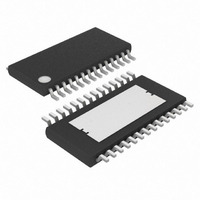MAX16807AUI+ Maxim Integrated Products, MAX16807AUI+ Datasheet - Page 13

MAX16807AUI+
Manufacturer Part Number
MAX16807AUI+
Description
IC LED DRVR WT/RGB BCKLT 28TSSOP
Manufacturer
Maxim Integrated Products
Type
Backlight, White LED, RGB (Serial Interface)r
Datasheet
1.MAX16807AUIT.pdf
(19 pages)
Specifications of MAX16807AUI+
Constant Current
Yes
Topology
Open Drain, PWM, Step-Down (Buck), SEPIC, Step-Up (Boost)
Number Of Outputs
8
Internal Driver
Yes
Type - Primary
Backlight
Type - Secondary
RGB, White LED
Frequency
20kHz ~ 1MHz
Voltage - Supply
8 V ~ 26.5 V
Voltage - Output
36V
Mounting Type
Surface Mount
Package / Case
28-TSSOP Exposed Pad, 28-eTSSOP, 28-HTSSOP
Operating Temperature
-40°C ~ 125°C
Current - Output / Channel
55mA
Internal Switch(s)
No
Low Level Output Current
55 mA
Operating Supply Voltage
8 V to 24 V
Maximum Supply Current
5 mA
Maximum Power Dissipation
2162 mW
Maximum Operating Temperature
+ 125 C
Mounting Style
SMD/SMT
Minimum Operating Temperature
- 40 C
Lead Free Status / RoHS Status
Lead free / RoHS Compliant
Efficiency
-
Lead Free Status / Rohs Status
Lead free / RoHS Compliant
Figure 1c. OUT_ Driver Internal Diagram
The advantages of current-mode control over voltage-
mode control are twofold. First, there is the feed-for-
ward characteristic brought on by the controller’s ability
to adjust for variations in the input voltage on a cycle-
by-cycle basis. Second, the stability requirements of
the current-mode controller are reduced to that of a sin-
gle pole system unlike the double pole in the voltage-
mode control scheme. The MAX16807 uses a
current-mode control loop where the output of the error
amplifier is compared to the current-sense voltage
(V
inverting input of the CPWM comparator, the output of
the comparator is low and the switch is turned on at
each clock pulse. When the current-sense signal is
higher than the inverting input of the CPWM compara-
tor, the output is high and the switch is turned off.
The turn-on supply voltage for the MAX16807 is 8.4V
(typ). Once V
There is a 0.8V of hysteresis from the turn-on voltage to
the UVLO threshold. Once V
MAX16807 operates with V
V
UVLO, the quiescent supply current into V
to 32µA (typ), and OUT and REF are pulled low.
OUT drives an external n-channel MOSFET and swings
from AGND to V
absolute maximum V
OUT is a push-pull output with the on-resistance of the
CC
CS
). When the current-sense signal is lower than the
goes below 7.6V, the device is in UVLO. When in
1.23V
CC
R
1.23
EST
CC
SET
reaches 8.4V, the reference powers up.
Switch-Mode Boost and SEPIC Controller
Undervoltage Lockout (UVLO)
68W/L
Switch-Mode Controller
______________________________________________________________________________________
. Ensure that V
Current-Mode Control Loop
GS
rating of the external MOSFET.
V+
Integrated 8-Channel LED Driver with
CC
995R
down to 7.6V (typ). Once
W/L
CC
CC
reaches 8.4V, the
MOSFET Driver
remains below the
CC
PGND
R
falls back
OUT_
pMOS typically 3.5Ω and the on-resistance of the
nMOS typically 4.5Ω. The driver can source 2A and
sink 1A typically. This allows for the MAX16807 to
quickly turn on and off high gate-charge MOSFETs.
Bypass V
to AGND, placed close to the V
current sourced to drive the external MOSFET depends
on the total gate charge (Q
of the converter. The power dissipation in the
MAX16807 is a function of the average output drive
current (I
the power dissipation in the device due to I
where I
Typical Operating Characteristics for the operating
supply current at a given frequency.
The MAX16807 includes an internal error amplifier. The
inverting input is at FB and the noninverting input is
internally connected to a 2.5V reference. Set the output
voltage using a resistive divider between output of the
converter V
mula to set the output voltage:
where V
The oscillator frequency is programmable using an
external capacitor and a resistor at RTCT (see R
C
from RTCT to the 5V reference (REF), and C
nected from RTCT to AGND. REF charges C
R
through an 8.3mA internal current sink until C
reaches 1.1V, at which time C
through R
the charge and discharge times of C
charge time as follows:
where t
Farads (F).
The discharge time is then:
where t
Farads (F).
T
T
t
in the Typical Operating Circuits ). R
until its voltage reaches 2.8V. C
D
= (R
CC
FB
C
D
DRIVE
CC
T
T
is in seconds, R
is in seconds, R
= 2.5V.
OUT
is the operating supply current. See the
again. The oscillator’s period is the sum of
x C
with one or more 0.1µF ceramic capacitors
). Use the following equation to calculate
PD = (I
V
T
, FB, and AGND. Use the following for-
OUT
x 1000) / [(4.88 x R
I
t
DRIVE
C
= 0.57 x R
=
DRIVE
⎛
⎜
⎝
= (Q
1
+
G
+ I
T
T
) and operating frequency
G
R
R
in ohms (Ω), and C
in ohms (Ω), and C
CC
2
1
T
x f
T
⎞
⎟
⎠
x C
) x V
CC
SW
is allowed to charge
x V
T
T
Error Amplifier
)
T
) - (1.8 x 1000)]
pin. The average
CC
FB
then discharges
T
. Calculate the
T
is connected
DRIVE
Oscillator
T
T
’s voltage
T
through
:
is con-
T
and
T
T
13
in
in











